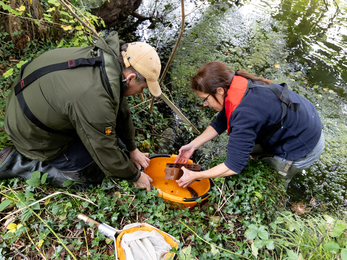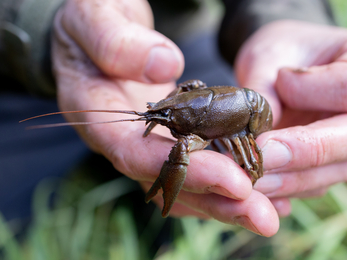Working with partners at The National Trust, The Woodland Trust and Staffordshire Wildlife Trust, Derbyshire Wildlife Trust has led a project to relocate the native white-clawed crayfish in lakes at Kedleston Hall, which are under threat from the non-native signal crayfish present downstream at Markeaton Park, and move them to a new site where their numbers can grow.
Teams from all four charities spent a day checking artificial refuge traps that were placed at strategic locations through the lakes system at points where concentrated populations of white-clawed crayfish exist, and performing health checks on the crayfish at Kedleston to ensure they were ready for the move. The following day, the crayfish were collected and transported to a secret location owned by the Woodland Trust in Derbyshire where it is hoped the crayfish will thrive.
Nick Mott, River Restoration Manager at Staffordshire Wildlife Trust, and Pete Cowley, Technical Director of Aquatic Ecology at AECOM in Nottingham, have been involved in the project over the last year, undertaking surveys, giving technical guidance and carrying out eDNA sampling to ensure that everything was in place prior to the crayfish translocation. Members of the AECOM Aquatic Ecology and Water Environment team have utilised Social Value days to assist with the crayfish translocation.
A generous donation of a pallet of bricks from Ibstock Brick Company have been provided to help with the building of artificial refuges and trapping of the white-clawed crayfish. In addition to this we received free e-DNA sampling kits from Nature Metrics who then processed the water samples to check for crayfish plague and the presence of white-clawed crayfish and american signal crayfish.
The species has been in decline since non-native American signal crayfish escaped into UK waters in the 1970s. Signal crayfish are bigger and stronger than the white-clawed, can feed on them, out- compete them for homes and food, and carry a disease fatal to the UK species.


